Reliable and suitable for cultivation in harsh climates, the Leningradskaya black cherry variety
Leningrad black is a real success of Russian breeders. They managed to develop a sweet cherry variety that not only retained the taste characteristics of the crop, but was also suitable for cultivation in the Northwest regions. We will tell you about the features of the variety, the rules for planting seedlings and caring for them.
The content of the article
Features of the Leningradskaya black cherry variety
This variety is a table variety with a medium late ripening period., fast-growing - fruiting begins 3-4 years after planting.

Due to uneven ripening, berries are removed 2-3 times per season., from late June to early September. The yield is average, but stable: in the first years of crown growth, 20-25 kg of fruits are removed from the tree, after the onset of the full fruiting age - 30-40 kg.
Reference. Not fully ripe berries at a temperature of + 6 ... + 7 ° C are stored for 2-3 weeks.
History of origin and distribution
The variety was bred by the breeder of the Pavlovsk Experimental Station of the All-Russian Institute of Plant Industry F.K. Teterev. Recommended for growing in the central part of Russia and the southern regions of the North-West region.
Characteristics and description of trees
Leningrad black is a medium-sized tree (height in adulthood - 3-4 m) with a wide, spreading, medium thickened crown. The bark covering the trunk and shoots is smooth, without cracks, and dark brown in color.
The leaf plates are large, elongated-oval, rich emerald. The central veins are thin, but well pronounced, the edges are serrate.
During floweringwhich falls in early or mid-May, medium-sized white flowers appear on the trees, collected in inflorescences of 3-7 pcs.
Resistant to temperatures
This is one of the most frost-resistant varieties cherries... It can withstand temperatures as low as -30 ° C and is not afraid of return frosts in spring.
Moisture and drought resistance
The variety is characterized by an average degree of drought tolerance.... Lack of moisture during flowering and ripening of fruits leads to the fall of the ovaries and loss of yield.
Stagnant water and high soil moisture - the cause of the watery pulp, cracking and decay of berries on trees even before they are fully ripe.
Disease and pest resistance
The variety has immunity to pests and diseases, but under unfavorable conditions and insufficient care, it can be affected by cherry flies, leaf rollers, tube worms, aphids, sawflies, birds, as well as moniliosis, chlorosis, coccomycosis.
Characteristics and description of berries
Berries of medium size, round or wide-heart shaped, weigh 3-4 g, covered with a thin skin, which at the beginning of ripening is colored ruby red, and then becomes dark burgundy, almost black.
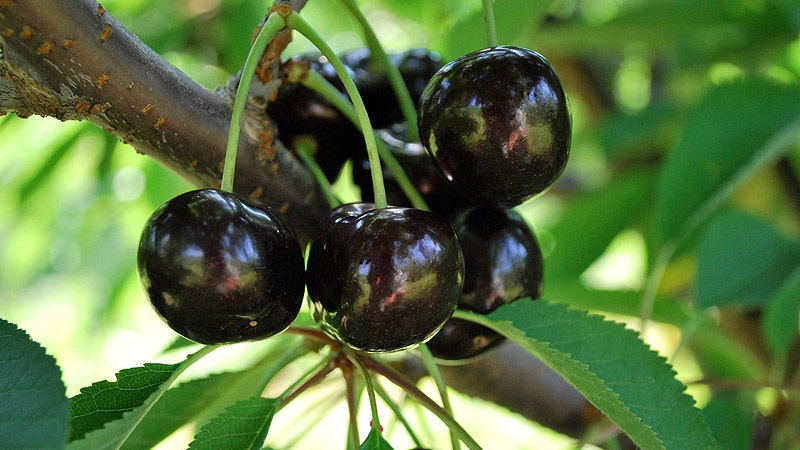
The bone is small, poorly separated... The pulp is dark red, tender and juicy, has a sweet taste and a spicy aftertaste with a slight acidity.
Reference. If the summer is sunny and dry, the berries ripen sugary-sweet; rainy weather makes them watery with a bland taste.
Application area
The fruits of the Leningrad black are characterized by the possibility of universal application.... They are eaten fresh, frozen, used for making desserts, assorted fruits, preserves or compotes.
Advantages and disadvantages of the variety
The advantages of the variety:
- medium tree growth, facilitating harvesting;
- early maturity;
- great taste of berries;
- the possibility of universal application;
- lack of tendency to shedding;
- extended ripening period;
- immunity to diseases and pests;
- frost resistance;
- stable fruiting.
Disadvantages of the Leningrad black:
- the need for pollinator varieties due to self-fertility;
- average yield;
- deterioration in the quality and taste of fruits in case of heavy rainfall;
- decrease or loss of yield during prolonged drought.
Growing technology
The main conditions for the successful cultivation of cherries - the correct choice of the planting site and seedlings and competent care for them.
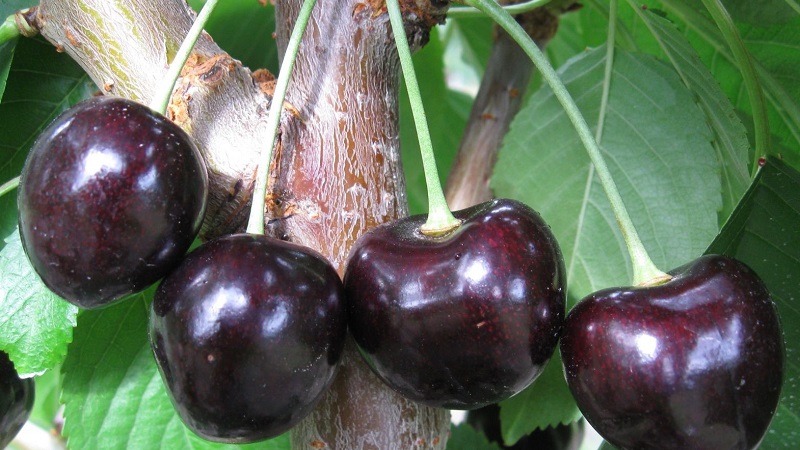
Optimal conditions
The variety prefers light, fertile soil with good aeration and moisture permeability... The best option is loam and sandy loam.
Planting material is bought in the spring, before the buds open., or in autumn, when the leaves fall on the seedlings and the sap flow ends. Preference is given to one-year (0.8-1 m high) without branches or biennial (no more than 1.5 m high) with 2-3 branches and one guide specimens without damage and signs of disease.
If the root system is dried, before planting it is soaked for 2-10 hours in water with the addition of 2-3 drops of a growth stimulator ("Kornerost").
Terms and rules of landing
For planting Leningrad black, choose a well-lit, a place protected from the cold gusty wind, located in the south. It should be flat or slightly sloped south or southwest. The permissible groundwater level is 2 m and below.
Cherries are planted on the plot in spring, before the buds swell, so that for 8 months of the growing season the tree takes root and grows stronger.
Reference. In southern regions with mild winters autumn is acceptable (no later than mid-October) planting provided additional protection of the seedlings from frost.
Good neighbors for cherries - cherry, mountain ash, other varieties of sweet cherry, black elderberry, grapes, hawthorn. Leningrad black is not planted next to apple trees, pears, plums, raspberries, apricots, sea buckthorn, black and red currants, gooseberries, viburnum.
Solanaceous crops are not planted under trees (tomatoes, peppers and eggplants), but planting at the base of melliferous flowers (for example, alfalfa or phacelia) helps to attract pollinating insects.
Landing rules:
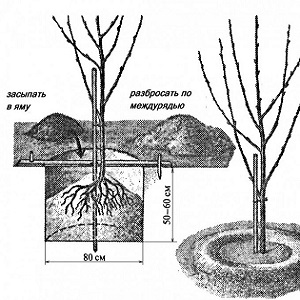 2-3 weeks before planting, dig planting holes with a diameter of 80-90 cm and a depth of 60-70 cm on the site.
2-3 weeks before planting, dig planting holes with a diameter of 80-90 cm and a depth of 60-70 cm on the site.- Fill each with two-thirds of a fertile mixture (half of the excavated earth, two buckets of humus or compost, 1 kg of wood ash, 200 g of superphosphate, 40 g of potassium salt).
- Immediately before planting, water the hole, and dig a wooden stake 1-1.5 m long into the center in order to further tie up the tree.
- Place the seedling in a hole, spread its roots, sprinkle it with earth so that the root collar is 5-8 cm above the soil surface.
- Water and mulch the soil.
Trees are planted in the distance 3-4 m from each other.
Further care
Cherries are watered three times per season (before flowering, mid-July and late autumn) subject to sufficient rainfall and 4-5 times a month in case of drought. Two buckets of warm, settled water are poured under each tree.
After watering or rain, the soil is loosenedto eliminate stagnant moisture and help the roots to better absorb nutrients and water. The earth in the near-trunk circle is regularly weeded.
Fertilization chart:
- spring, during the blooming of leaves - infusion of mullein or a mineral complex (20 g of urea, potassium salt and superphosphate per 10 liters of water);
- after harvesting - potassium-phosphorus fertilizers.
Every year in spring, before the buds swell, or in late autumn, trees are pruned, removing dry, frozen and thickening shoots. The sparse-tiered crown is given within 5-6 years.
Possible problems, diseases, pests
Diseases and pests that can infect Leningradskaya black are described in the table:
| Disease, pest | Signs | Treatment |
| Cherry fly | Black dots appear on the berries, then depressions, which gradually rot; the outer part of the rind loses its shine, and the flesh becomes limp. | Trees are sprayed twice with an interval of 10 days with insecticidal preparations (Arrivo, Fury, Confidor, Decis, Fufanon, Iskra, Aktellik). Also, to scare away insects, plantings are treated with tobacco, coniferous or garlic infusions. |
| Leaf roll | A cobweb appears on the leaves of the cherry, the caterpillars turn out the leaf plates and eat them. | |
| Cherry pipe runner | Adult insects feed on buds, buds, flowers, ovary and fruits; the larvae are drilled into the bone and feed on the nucleus. | The soil is dug up, the beetles are mechanically shaken off the branches, the trees are treated with Aktara or organophosphate pesticides (Metaphos, Karbofos, Benzophosphate). |
| Cherry aphid | The larvae feed on leaf juices, due to which the growth of the central vein stops, the leaves curl, turn black and dry out. | In the spring trees are treated with insect-acaricides (Aktelik, Karbofos, Inta-Vir), sprayed with infusion of dandelion leaves, onion feathers, elderberry inflorescences. If the buds have already blossomed, use the drugs "Confidor", "Aktofit". |
| Sawflies | Pests gnaw out the upper layers of the leaf plates, as a result of which the latter become covered with translucent spots. | |
| Moniliosis | Leaves, flowers and berries dry out prematurely. | Infected branches are removed and burned, the tree is treated three times with an interval of seven days with antifungal drugs "Horus", "Abiga-peak", "HOM" or "Strobi". |
| Chlorosis | Yellowing and falling leaves. | |
| Coccomycosis | First, spots of pink-brown color appear on the leaves, then the underside of the leaf plates is covered with a pale pink bloom. |
To protect against birds during the ripening of berries, they hang on trees rustling ribbons, shiny foil or covering the crowns with special nets.
Wintering
Due to the high degree of frost resistance winter shelter in the form of agrofibre and spruce branches is needed only for young trees up to 4 years old. To protect against rodents, a special mesh or roofing material is attached to the trunks.
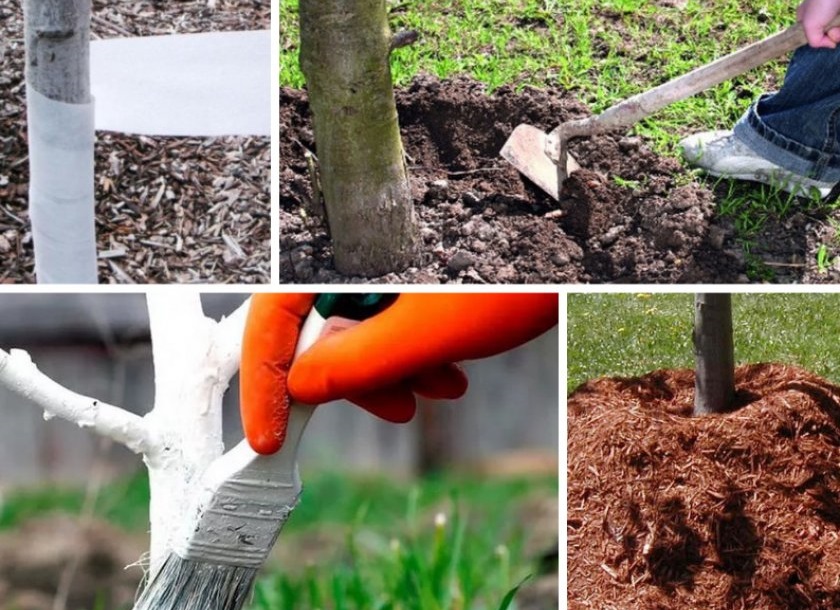
Mature trees are watered abundantly in late autumn, and the earth in the near-trunk circle is mulched with peat, straw or humus.
Reproduction
Breeders grow cherries from seeds, since with this method of reproduction, the tree loses its varietal characteristics. The best way to propagate a culture is by cuttings.
Cuttings are harvested from early to mid-Junecutting developed and vigorous shoots into pieces with a maximum length of 30 cm so that there are 3-5 leaves on the stem, and 2-3 in the lower part. The cut is made with a sharp clerical knife at an angle of 45 ° at the bottom and 90 ° at the top.
Cuttings 1-3 cm dipped in a growth stimulator solution ("Kornevin", "Epin"), are planted in a moist and loose substrate with low acidity for rooting and removed to a warm place (+ 25 ... + 30 ° C), regularly sprinkling with water from a sprayer.
Rooting takes up to 50 days.
Features of growing varieties depending on the region
This frost-resistant variety grows well and bears fruit even in the northern regions.... There are practically no differences due to the climatic conditions of the region in the care of cherries.
Consider only the need for shelter in regions with harsh winters and the frequency of watering when grown in areas with hot, dry summers.
Pollinating varieties
Leningrad black - self-fertile variety... For the formation of the crop, several other varieties of sweet cherries are planted nearby, matching the level of frost resistance and flowering time.
The best pollinating varieties:
- Iput;
- Tyutchevka;
- Fatezh;
- Ovstuzhenka;
- Veda;
- Bryansk pink;
- Bryanochka;
- Michurinka;
- Leningradskaya with yellow and pink fruits;
- Chermashnaya;
- Dawn;
- Jealous;
- Seda;
- Teremoshka;
- Red dense.
Also, flowers are pollinated by bees, to attract which honey-bearing flowers are planted under the trees or install hives in the garden.
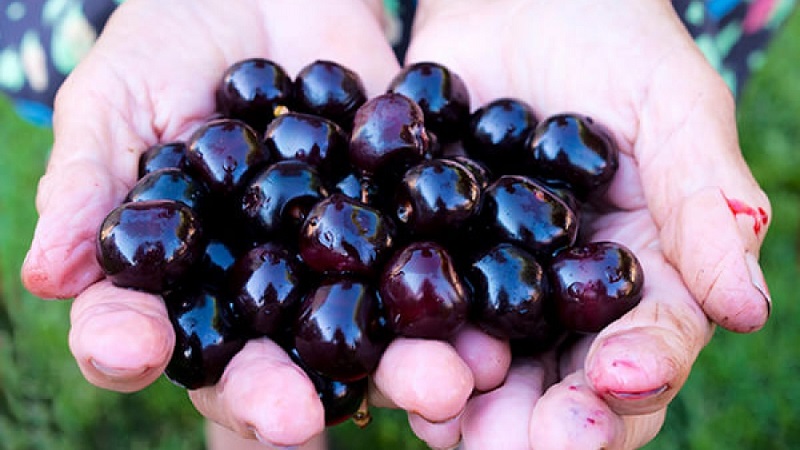
Gardeners reviews
Summer residents speak positively about the variety:
Elena, St. Petersburg: “I have wanted to plant cherries for a long time, but I didn’t know which variety to choose for our climate. We advised Leningradskaya Black as a frost-resistant and fruitful variety. I bought several seedlings and took Fatezh as pollinators; last year I already harvested. The tree is not tall, only 2 m at the moment. The berries are small, but very sweet ".
Vitaly, Moscow region: “I have several varieties of sweet cherry, including Leningradskaya black. I love this variety for its frost resistance and beautiful, maroon berries. They are juicy, sweet, with a subtle sourness ".
Conclusion
Cherry Leningradskaya black is an excellent choice for gardeners from the northern regions. The variety is characterized by a high degree of frost resistance, unpretentiousness, strong immunity and juicy berries with a sweet and sour taste.